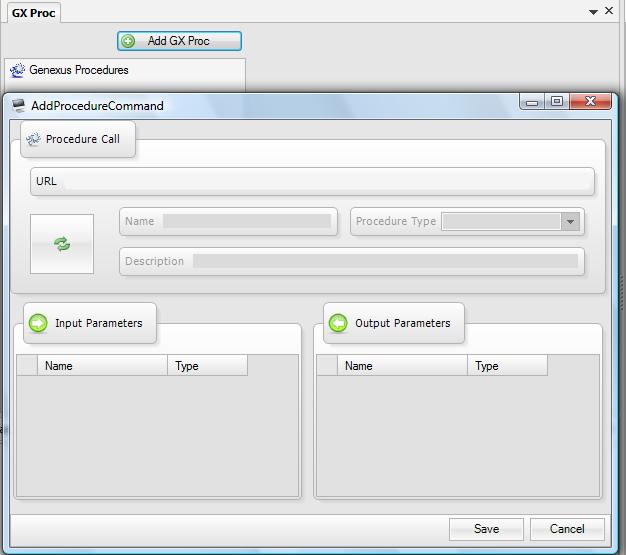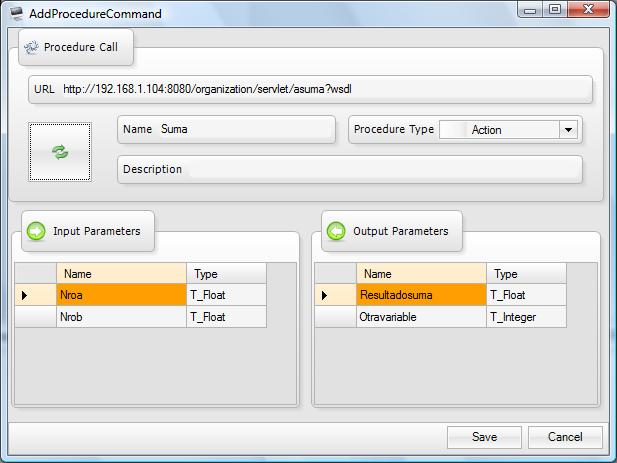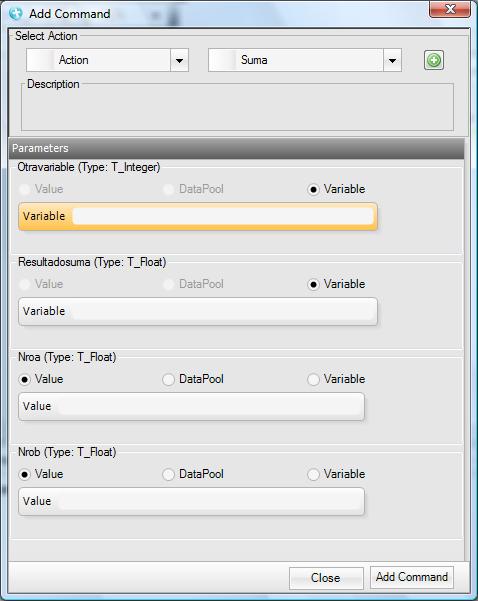Difference between revisions of "Creating a command to use a GeneXus Procedure"
(Página nueva: Categoría: Guías de GXtest La invocación a Procedimientos Genexus desde los Test Cases de GXtest dan la posibilidad de ingresar validaciones a nivel de datos (implementando l...) |
|||
| (9 intermediate revisions by 5 users not shown) | |||
| Line 1: | Line 1: | ||
| − | [[ | + | {{Idiomas | Crear un Comando para invocación a un Procedimiento GeneXus | Creating a command to use a GeneXus Procedure | GeneXus のプロシージャーを使用するコマンドの作成}} |
| + | [[Category: GXtest Guides]] | ||
| − | + | Using a GeneXus Procedure from within a GXtest Test Case makes it possible to enter validation at the data level (implementing GeneXus logic to verify the expected state of a database) or to run whatever kind of action or calculation with GeneXus programs. They can have any number of input and output parameters. | |
| − | == | + | == Creating a GX Proc == |
| − | + | First you’ll see how to create a GX Proc in GeneXus so that it is exposed as a Web Service and then how to load it into GXtest. | |
| − | === | + | === Defining a Procedure as a GeneXus Web Service === |
| − | + | Here is an example of how to create an addition procedure. This can be used to have GXtest add together two numbers in a Test Case. | |
| − | + | Definition of the procedure: | |
'''Rules''' | '''Rules''' | ||
| − | Parm(in:& | + | Parm(in:&NumA, in:&NumB, |
| − | out:& | + | out:&ResultSum,out:&OtherVariable); |
| − | + | In the example there are two outputs, the result of the addition and another value, which are included only to show that it is possible to manage several output parameters at the GXtest level. | |
'''Source''' | '''Source''' | ||
| − | & | + | &ResultSum = &NumA+&NumB |
| − | & | + | &OtherVariable = 4 |
| − | ''' | + | '''Properties''' |
* Call Protocol: SOAP | * Call Protocol: SOAP | ||
* Main Program: True | * Main Program: True | ||
| − | === | + | === Loading the Procedure into GXtest === |
| − | + | Open the menu to create the GX Proc. | |
[[image:AccesoProcGX.jpg]] | [[image:AccesoProcGX.jpg]] | ||
| − | + | Then click on Add GX Proc that will bring up a window where you can load the GeneXus Procedure: | |
| − | + | ||
[[image:definirProcGX.jpg]] | [[image:definirProcGX.jpg]] | ||
| + | Here you can enter the URL to the GeneXus Procedure’s WSDL and click [[image:botonRefresh.jpg]]. | ||
| − | + | Once done it will have loaded the procedure's definition and you can see then name and the input and output parameters for the procedure. In the addition example you can see in the following image how the parameters are displayed. | |
| − | + | ||
| − | + | ||
[[image:procSuma.jpg]] | [[image:procSuma.jpg]] | ||
| + | Here you can edit the name that will refer to the command, the description and whether you will use Action or Validation. | ||
| − | + | == Using a GX Proc == | |
| − | + | Once you have created the GX Proc it is ready to be used by GXtest the same way as any other native command, allowing you to add it and edit it manually. | |
| − | == | + | |
| − | + | ||
[[image:usarProgGX.jpg]] | [[image:usarProgGX.jpg]] | ||
| + | Note that you can load the output parameters into variables and the input parameters can be come from a variable, fixed values and Data Pools. | ||
| + | |||
| + | == Adding procedures used like validations == | ||
| + | Sometimes you need to use a GX Procedure to evaluate a condition in your database. | ||
| + | This kind of procedures, could only have one output value: The True/False response. | ||
| + | |||
| + | |||
| + | This output could be "T" for True conditions, and any other string, to False ones. | ||
| + | |||
| + | For example: | ||
| − | + | If you build a procedure named ExistClient (in: idClient) | |
| + | The returned value "T" will mean that client with id = idClient exist, otherwise, you can return a text like "The client doesn't exists", and GXtest will assume that is a False response. | ||
Latest revision as of 19:52, 20 February 2014
Using a GeneXus Procedure from within a GXtest Test Case makes it possible to enter validation at the data level (implementing GeneXus logic to verify the expected state of a database) or to run whatever kind of action or calculation with GeneXus programs. They can have any number of input and output parameters.
Contents |
Creating a GX Proc
First you’ll see how to create a GX Proc in GeneXus so that it is exposed as a Web Service and then how to load it into GXtest.
Defining a Procedure as a GeneXus Web Service
Here is an example of how to create an addition procedure. This can be used to have GXtest add together two numbers in a Test Case.
Definition of the procedure:
Rules
Parm(in:&NumA, in:&NumB,
out:&ResultSum,out:&OtherVariable);
In the example there are two outputs, the result of the addition and another value, which are included only to show that it is possible to manage several output parameters at the GXtest level.
Source
&ResultSum = &NumA+&NumB &OtherVariable = 4
Properties
- Call Protocol: SOAP
- Main Program: True
Loading the Procedure into GXtest
Open the menu to create the GX Proc.
Then click on Add GX Proc that will bring up a window where you can load the GeneXus Procedure:
Here you can enter the URL to the GeneXus Procedure’s WSDL and click  .
.
Once done it will have loaded the procedure's definition and you can see then name and the input and output parameters for the procedure. In the addition example you can see in the following image how the parameters are displayed.
Here you can edit the name that will refer to the command, the description and whether you will use Action or Validation.
Using a GX Proc
Once you have created the GX Proc it is ready to be used by GXtest the same way as any other native command, allowing you to add it and edit it manually.
Note that you can load the output parameters into variables and the input parameters can be come from a variable, fixed values and Data Pools.
Adding procedures used like validations
Sometimes you need to use a GX Procedure to evaluate a condition in your database. This kind of procedures, could only have one output value: The True/False response.
This output could be "T" for True conditions, and any other string, to False ones.
For example:
If you build a procedure named ExistClient (in: idClient) The returned value "T" will mean that client with id = idClient exist, otherwise, you can return a text like "The client doesn't exists", and GXtest will assume that is a False response.



